Effective Crabgrass Management for a Thriving Lawn
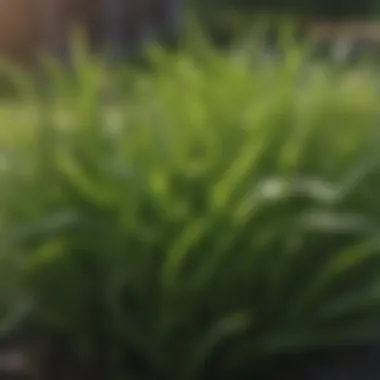

Intro
Crabgrass, a common annual weed, poses a significant threat to the health and appearance of lawns across many regions. Understanding its unique biology and growth patterns can arm homeowners with the knowledge to combat it effectively. This article provides a detailed exploration of strategies to manage crabgrass while preserving an established lawn's integrity. By addressing topics such as assessment techniques, prevention methods, and selective control tactics, the discussion aims to equip readers with practical, scientifically-grounded approaches to fight this invasive weed.
Understanding Crabgrass Biology
Crabgrass, known scientifically as Digitaria sanguinalis, thrives in warm climates and can spread quickly if not managed. It germinates when soil temperatures rise above 55 degrees Fahrenheit, typically in late spring. Recognizing its life cycle is crucial to implementing effective control measures. Crabgrass seeds can remain dormant in the soil for several years, making it imperative to address the problem promptly before the seeds proliferate.
Assessment Techniques
Identifying the presence of crabgrass early can save homeowners time and resources. Walk through the lawn regularly, paying attention to areas with loose soil, high foot traffic, or poor drainage. Look for the characteristic wide blades that grow low to the ground. A visual inspection, coupled with soil testing, can provide insights into the health of the lawn and the extent of crabgrass infiltration.
Prevention Measures
Preventing crabgrass from taking hold is perhaps the most effective strategy for homeowners. Here are some techniques to consider:
- Maintain a Dense Lawn: A thick, healthy lawn can compete with weeds. Regular mowing and appropriate fertilization can enhance grass density.
- Proper Watering: Ensure even watering patterns. Deep and infrequent watering promotes deep root growth and discourages crabgrass establishment.
- Mulching: Applying organic mulch around garden beds can prevent crabgrass seeds from receiving sunlight, thus stunting their growth.
Selective Control Tactics
For areas where crabgrass has already emerged, a selective approach to control allows homeowners to manage the weed without harming desirable grasses. Consider the following methods:
- Pre-emergent Herbicides: Applying these in early spring can prevent crabgrass seeds from germinating. Brands like Pendimethalin or Prodiamine have proven effective.
- Post-emergent Herbicides: If crabgrass is already visible, products containing Quinclorac can selectively target crabgrass without compromising healthy grass.
- Hand Pulling: In small infestations, manually removing crabgrass can be effective. Ensure the entire root is removed to prevent regrowth.
Regular maintenance and prompt action are essential in preserving lawn health while managing crabgrass effectively.
End
Combating crabgrass involves understanding its biology and implementing tailored strategies that preserve lawn integrity. By employing preventative measures and specific control methods, homeowners can maintain lush, green lawns. Knowledge is a powerful tool in lawn management, and with informed decision-making, crabgrass can be kept at bay. Stay vigilant, and your lawn can remain a source of pride.
Understanding Crabgrass
Crabgrass is a common challenge for homeowners aiming to preserve a lush lawn. Understanding its biology and growth patterns is vital to effectively manage this weed. As an adaptable and resilient plant, crabgrass can quickly overtake established grass if not controlled. By recognizing its traits and the environments that favor its proliferation, homeowners can implement better strategies for prevention and eradication.
Biology of Crabgrass
Crabgrass, scientifically known as Digitaria, is a warm-season annual grass. It germinates from seeds and spreads through both seed production and vegetative growth. The life cycle usually begins in spring when soil temperatures reach around 55°F (13°C). The germinated seeds can produce a dense carpet of crabgrass, competing with desirable lawn species for nutrients, water, and light.
The biology of crabgrass includes features like its broad leaves and ability to grow in a variety of soil types. Understanding its reproductive strategies is critical. Crabgrass can produce thousands of seeds in a single season. Moreover, the seeds can remain dormant for several years, making long-term management a challenge.
Crabgrass Growth Patterns
Crabgrass has a distinctive growth pattern. It typically spreads horizontally, forming a mat close to the ground. This growth habit allows it to crowd out other plants. During warm and dry spells, its growth can accelerate rapidly. Homeowners often notice its presence when it's already well-established.
Its growth can be categorized into several stages: germination, establishment, and flowering. The flowering phase, which occurs in summer, signals the time when crabgrass seeds are produced. Controlling crabgrass before it reaches the flowering stage is key to reducing its population the following year.
Environmental Conditions Favoring Crabgrass
Crabgrass thrives in specific environmental conditions. Warm temperatures, direct sunlight, and minimal competition from desirable grass species create ideal circumstances for crabgrass. It is particularly aggressive in poorly maintained lawns that suffer from drought or nutrient deficiencies.


Factors that favor the growth of crabgrass include:
- Poor Soil Quality: Nutrient-deficient or compacted soil often fails to support healthy grass, allowing crabgrass to thrive.
- Insufficient Watering: Lawns that are not watered adequately can become stressed, offering crabgrass an opportunity to dominate.
- Mowing Height: Cutting grass too short weakens desirable species, giving crabgrass a competitive edge.
Understanding these conditions enables homeowners to adjust their lawn care practices. By improving soil health, adopting proper watering schedules, and maintaining appropriate mowing heights, the chance for crabgrass to take over can be significantly reduced.
"Effective lawn management requires understanding both your grass and your weeds."
By grasping these foundational elements, homeowners can begin to formulate a plan that benefits their lawns and minimizes the encroachment of crabgrass. Effective management lies in knowledge, observation, and intervention.
Assessing Crabgrass Infestation
Assessing crabgrass infestation is a vital aspect of lawn management. Early identification can prevent a small issue from turning into a major problem. Recognizing the presence of crabgrass allows homeowners to devise targeted strategies to mitigate its spread. Not only does assessing lawn health help in understanding the severity of the infestation, but it also equips you with the knowledge needed to take appropriate action.
Identifying Crabgrass in Your Lawn
Crabgrass can often be mistaken for other types of grass. However, there are particular characteristics to help in its identification. Look for wide leaves that grow in a prostrate manner. The leaf blades tend to be rough and take on a distinct blue-green color. Another key feature is its rapid growth pattern; it typically emerges earlier in the spring than many desirable turfgrasses. If you notice a patch that appears more ragged than the surrounding grass, it may be crabgrass.
Regular inspections of your lawn from late spring into summer are essential. Using a magnifying glass can aid in identifying the fine details of the leaves and stems. Take note of any unusual growth patterns; this can signal deeper issues with crabgrass.
Evaluating Lawn Health
Evaluating the overall health of your lawn is crucial in understanding how crabgrass affects it. A robust lawn can often compete effectively against weeds, but a weakened lawn serves as an open invitation for invasive species. Check for signs of stress in your grass, such as discoloration, patchiness, or thin coverage. These factors may indicate deficiencies in soil nutrients or improper watering habits, paving the way for crabgrass.
Maintaining this evaluation involves regular soil tests. These tests identify nutrient levels and help determine pH, which influences growth. Taking action based on this information may improve lawn health. Additionally, watch for common ailments like pests or diseases, as they further compromise the lawn’s ability to fend off crabgrass.
Timing for Assessment
The timing of your assessment efforts is critical. Crabgrass germinates when soil temperatures reach around 55°F (approximately 13°C), typically in early spring. Thus, planning assessments around this time allows homeowners to catch potential infestations in their infancy.
Regular inspections during April and early May can facilitate this. Additionally, continue monitoring throughout the growing season since crabgrass can establish itself late into summer. This consistent attention to timing enables timely intervention, heightening the chances of effective management while preserving lawn integrity.
Preventive Measures
Preventive measures are foundational in the management of crabgrass and the overall health of your lawn. Implementing these strategies can significantly reduce the likelihood of crabgrass infestation. A healthy lawn is your first line of defense against many invasive weeds. By establishing a robust turf, you minimize open spaces where crabgrass and other weeds can thrive.
Establishing a Strong Lawn
Creating a strong lawn begins with choosing the right grass variety for your region. Native grasses are often more resilient and better suited for local environmental conditions. Proper seed selection greatly impacts the lawn's ability to compete against weeds. Additionally, ensure your lawn receives adequate soil preparation, which includes testing the soil pH, and addressing any deficiencies. Healthy turfroots penetrate deeper into the soil, allowing them to access necessary nutrients and moisture.
A well-established lawn can reduce crabgrass germination by up to 90%.
Mowing Techniques
Mowing is more than just a routine task. Establishing the right mowing height is essential to lawn health. Keeping grass taller can shade the soil, making it more difficult for crabgrass seeds to germinate. For example, maintaining a height of about three inches is beneficial for most grass types. It helps in crowding out crabgrass and other weeds while promoting a denser turf. Make sure to use a sharp mower blade to prevent tearing the grass, which can open wounds and create opportunities for diseases and weeds to take hold.
Watering Regimen
A consistent watering regimen is critical. Overwatering can create conditions that favor crabgrass. Watering deeply and less frequently encourages deep root growth, making grasses more resilient. Ideally, aim for one inch of water per week. Early morning is the best time to water, reducing evaporation losses and fungal issues. Observing your lawn regularly helps you adjust your watering routine based on weather conditions and the specific needs of your grass type.
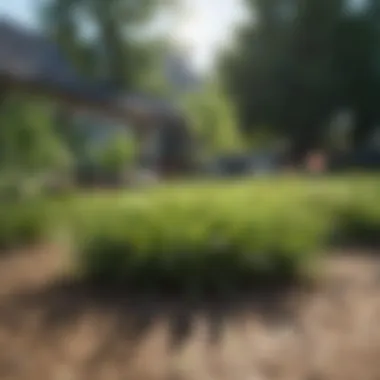
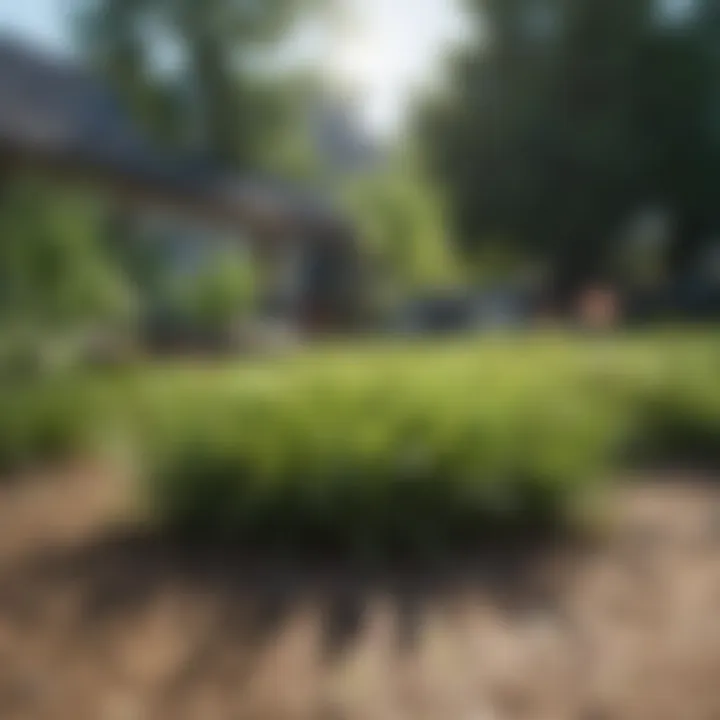
Fertilization Practices
Fertilizing your lawn appropriately promotes healthy growth. It is vital to apply fertilizers that match your soil's nutrient profile. A soil test reveals what your lawn needs most. Generally, a late spring application of a nitrogen-rich fertilizer supports your lawn's growth while hindering crabgrass seed germination. Avoid over-fertilizing, as it can lead to excessive thatch, which harbors weed seeds and impedes lawn health. Scheduled fertilization, aligned with the growing season, enhances the grass's vigor and reduces competition from weeds like crabgrass.
Selective Control Methods
Selective control methods are essential for managing crabgrass while ensuring the health and integrity of your lawn. Unlike broad-spectrum herbicides, selective methods target specific weeds without harming desirable grass species. This approach is particularly beneficial for homeowners who strive to maintain a vibrant and lush turf. Using selective methods fosters a balance in your lawn ecosystem, allowing for the flourishing of beneficial plants while minimizing the presence of invasive ones.
Herbicides: An Overview
Herbicides serve as a primary tool for controlling crabgrass. They work by inhibiting the growth of unwanted plants. However, understanding their mechanism and application can make a significant difference in effectiveness. Broadly, herbicides can be classified into pre-emergent and post-emergent types. Both have specific application timings and require careful consideration regarding lawn type and current plant presence to ensure effectiveness without causing harm to the grass.
Pre-emergent Herbicides
Pre-emergent herbicides are applied before crabgrass seeds germinate. Their primary function is to create a chemical barrier in the soil that prevents new weed seeds from developing. Timing is crucial with these herbicides. Application should occur early in the season, usually before the soil temperature reaches 55 degrees Fahrenheit for a sustained period, as this is often the threshold for crabgrass germination. Popular pre-emergent options include products containing pendimethalin or dithiopyr. Homeowners must follow label instructions carefully to avoid damaging their grass.
Post-emergent Herbicides
Post-emergent herbicides work on already established crabgrass. They are most effective when applied in the early stages of weed growth. These herbicides can be selective or non-selective, but it's advisable to choose products labeled as selective for lawn use. Ingredients like quinclorac or fenoxaprop are commonly found in selective post-emergent products. Application must be done when the lawn is healthy and actively growing to minimize any stress from the chemical treatment. Always consider the impact on desirable plants and follow the overlap periods recommended for re-application.
Natural Alternatives to Herbicides
For those who prefer a chemical-free approach, natural alternatives to conventional herbicides are available. These solutions often incorporate organic ingredients that inhibit crabgrass growth. Options include vinegars with high acetic acid content, corn gluten meal, and even boiling water. While these methods can be effective, they typically require more frequent applications and may have varying success rates compared to synthetic options. These methods also require some knowledge of application timing and concentration levels to work effectively. Monitoring lawn health before and after application is vital for best results.
"A strategy combining multiple methods often yields the best results, allowing for a sustainable approach to weed management."
By embracing selective control methods, homeowners can significantly reduce crabgrass populations while sustaining their lawns’ aesthetics and health. Each herbicide type, whether chemical or natural, has its benefits and considerations and should be chosen according to specific landscape and lawn requirements.
Integrated Weed Management
Integrated Weed Management (IWM) is a holistic approach, focusing on sustainable practices that combine various strategies to control crabgrass while preserving the overall health of your lawn. This method is critical for homeowners who desire a green and thriving lawn without the over-reliance on chemical herbicides, which can harm both the environment and beneficial organisms. IWM considers ecological factors, cultural practices, and biological techniques to create a more balanced and effective weed management system.
Cultural Practices
Cultural practices include the specific management techniques employed in lawn care that help prevent crabgrass and promote healthy turf. These practices can significantly reduce the chances of a crabgrass invasion.
- Soil Preparation: Healthy soil is foundational. Testing your soil allows you to understand its pH and nutrient levels. This knowledge guides amendments, ensuring your grass grows strong enough to outcompete weeds like crabgrass.
- Proper Mowing: Regular mowing, ideally at a height of 2.5 to 4 inches, allows grass to establish deep roots while shading out weed seeds, reducing crabgrass germination.
- Aeration: Aerating your lawn encourages air, nutrients, and moisture to reach the roots. It supports stronger grass growth, making lawns more resilient against invasive weeds.
- Mulching: In garden beds or around trees, using organic mulch blocks light from reaching crabgrass seeds, thus suppressing their growth.
Biological Controls
Biological control methods involve using living organisms to suppress crabgrass. This might be a less-known area but holds potential for sustainable weed management.
- Beneficial Insects: Introducing predatory insects that feed on crabgrass can reduce its prevalence. For example, certain beetles may consume young crabgrass seedlings.
- Microbial Solutions: Utilizing specific bacteria or fungi can improve soil health and create a less favorable environment for crabgrass to thrive. These microbes can compete with or inhibit the growth of crabgrass.
These biological approaches are gradually gaining traction but require patience and proper knowledge for effective implementation.
Monitoring and Adaptation
Continuous evaluation is key in Integrated Weed Management. By monitoring your lawn, you can adapt your strategies based on observed conditions and changes in crabgrass presence over time.
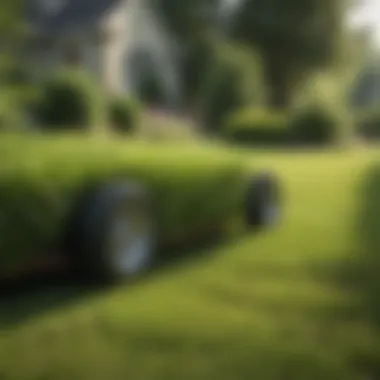
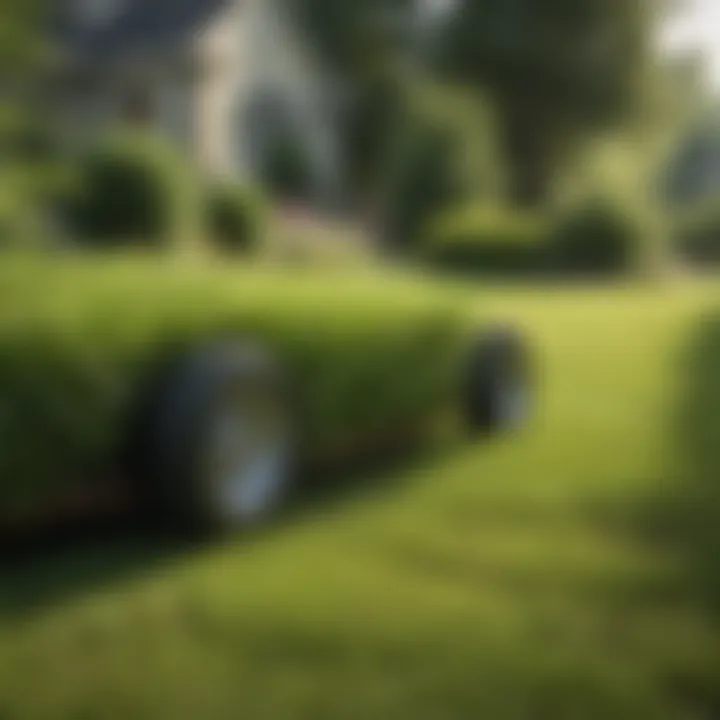
- Regular Inspections: Schedule times throughout the growing season to inspect your lawn. Identification of crabgrass at an early stage can lead to quicker intervention.
- Record Keeping: Maintain detailed notes on lawn conditions, weather patterns, and weed presence. This data can illuminate trends, assisting you in making informed decisions in future seasons.
- Adaptive Strategies: Be prepared to adjust your approach based on what works. If certain cultural practices prove ineffective, seek alternative methods, be they biological or mechanical control tactics.
Integrated Weed Management is not a one-time task, but an ongoing process of learning and adaptation.
Impact of Crabgrass on Lawn Ecosystems
Understanding the impact of crabgrass on lawn ecosystems is crucial for maintaining a vibrant and healthy turf. Crabgrass (Digitaria spp.) is an aggressive weed that competes for essential resources such as light, water, and nutrients. The presence of this invasive species can severely affect the overall health of the lawn. In particular, homeowners need to recognize how crabgrass influences both their lawns and the broader ecosystem they are part of.
Competition for Resources
Crabgrass is known for its rapid growth and ability to thrive in various environments. This weed can outcompete desirable grass species by monopolizing vital resources. When crabgrass establishes itself, it spreads quickly, creating dense mats that restrict sunlight from reaching the underlying turf.
- Light: As crabgrass grows taller, it casts shadow over the desirable grass, inhibiting their growth. This can lead to patchy areas and may encourage further weed intrusion.
- Water: Crabgrass has a higher tolerance for drought conditions which allows it to access water resources more efficiently than traditional grasses. This unbalanced competition can deprive the established lawn of necessary hydration.
- Nutrients: Nutrient uptake becomes skewed when crabgrass invades, as it can absorb fertilizers more effectively. This diminishes the nutrient availability for beneficial lawn grasses.
Soil Health Considerations
Crabgrass also poses challenges to soil health. When crabgrass dominates, it can lead to changes in soil composition and fertility. The high growth rates and subsequent die-off of crabgrass can result in uneven nutrient distribution in the soil. Here are some considerations:
- Soil Structure: The extensive root system of crabgrass can compact soil, disrupting the natural aeration needed for healthy grass roots.
- Nutrient Depletion: Crabgrass’ aggressive nature may lead to depletion of critical nutrients such as nitrogen, phosphorus, and potassium, which are essential for a healthy lawn.
- Microbial Activity: The presence of invasive species like crabgrass can alter microbial communities in the soil. A decrease in beneficial soil microbes can negatively affect the lawn’s ability to recover from stress and absorb nutrients.
Effects on Biodiversity
The impact of crabgrass on biodiversity is another area of concern for homeowners. As crabgrass proliferates, it can reduce the variety of plant species in the lawn. This reduction in plant diversity has several implications:
- Habitat Loss: A monoculture lawn dominated by crabgrass will not provide habitat for many beneficial insects or pollinators.
- Pest Dynamics: Crabgrass can unintentionally promote other pest species that thrive in environments devoid of competition. This imbalance can increase the need for pest control measures.
- Invasive Ecosystems: The presence of crabgrass can create a gateway for other invasive species to enter, further undermining local ecosystems.
Long-Term Strategies for Lawn Sustainability
The significance of long-term strategies for lawn sustainability cannot be overstated. Establishing resilient and thriving grass systems requires a commitment to practices that not only address current issues but also pave the way for ongoing health and vitality. Such strategies contribute to a balanced ecosystem, enhancing biodiversity while reducing reliance on chemical inputs. Effective management of crabgrass hinges upon these sustainable practices, allowing homeowners to cultivate lush lawns without falling victim to recurring weed infestations.
Understanding Soil Health
Soil health is the cornerstone of a successful lawn. It refers to the condition of soil as a living ecosystem capable of sustaining plant life. Healthy soils provide essential nutrients, support microbial activity, and promote water retention. To achieve optimal soil health, homeowners should consider conducting soil tests. These tests identify nutrient deficiencies and pH levels that may hinder grass growth.
Incorporating organic matter, such as compost or well-rotted manure, can dramatically improve soil structure and fertility. This addition not only nourishes grass but also enhances the soil’s ability to retain moisture, ultimately benefiting the overall environment. Well-aerated and structured soil helps reduce crabgrass proliferation by fostering strong grass roots that outcompete invasive weeds for resources.
Regular Maintenance Routines
Consistency is key in maintaining a sustainable lawn. A regular maintenance routine encompasses several essential tasks. Mowing at the appropriate height encourages healthy grass growth and density while preventing sunlight from reaching crabgrass seedlings. Ideally, grass should be cut to a length of about three inches, allowing for deep root development.
Fertilization should also follow a schedule tailored to the lawn’s specific nutrient needs, typically involving slow-release fertilizers in early spring and late summer. Regular watering, especially during periods of drought, is vital for keeping grass vigorous.
Consider implementing integrated pest management practices by monitoring for signs of crabgrass and other weeds. Prompt removal when they first appear can significantly lessen their spread and impact on the lawn.
Community Resources and Support
Homeowners do not have to navigate the challenges of lawn care alone. Engaging with community resources can provide valuable support in the quest for sustainable lawn management. Local garden clubs, extension services, or gardening workshops offer insights into best practices and can facilitate discussions about common challenges.
Additionally, online platforms such as forums on Reddit can serve as valuable spaces to gather tips, experiences, and advice on crabgrass management. Many homeowners share stories of their successes and failures, providing a wealth of practical knowledge.
Ultimately, building a network of support fosters a sense of community while promoting a collective commitment to sustainable practices. Together, homeowners can contribute to healthy lawns and environments in ways that are both practical and effective.
"Investing in long-term strategies enhances lawn resilience, ultimately leading to less dependence on chemical treatments and more enjoyment of a vibrant outdoor space."
By prioritizing soil health, maintaining rigorous routines, and leveraging community resources, homeowners can achieve lawns that thrive, resisting the encroachment of unwanted weeds like crabgrass.















